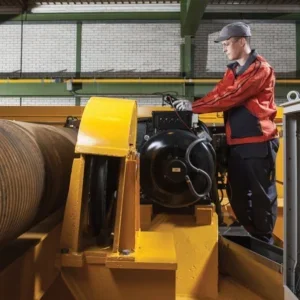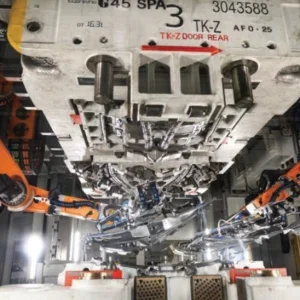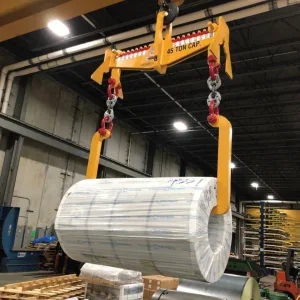Variable speed drives and industrial motors
Variable Speed Drives (VSDs) optimise the voltage and frequency supply to an industrial motor to change its speed of operation, rather than the traditional method of ‘choking’ constant speed motors. This greatly reduces consumption of electricity. Correctly designed VSD systems typically reduce energy consumption by 20 per cent and 70 per cent, depending on the application (1).
The most receptive applications tend to be pumps, fans and centrifugal compressors, although worthwhile savings may even be achieved on more demanding applications such as mixers, centrifuges, reciprocating compressors and extruders.
In addition to providing substantial energy reduction, other VSD benefits include soft start-up of the equipment, reduced current on starting, reduced mechanical stress and high power factor. VSDs are intelligent devices that can easily be integrated into energy management systems, and may also be a key component in dynamic power management by helping with tariff management and demand reduction.
The gains to be made from installing VSDs should not be confused with the process of installing motors which themselves are more energy efficient. Both activities – installing VSDs, and replacing inefficient motors with more energy-efficient models – will yield energy cost savings.
As far as industrial electric motors are concerned, legislative efforts have been underway in several countries for over a decade to encourage the transition to more efficient electric motor-driven systems. These include the implementation of Minimum Energy Performance Standards (MEPS) requiring that electric motors meet a certain efficiency level in order to enter the national market. For example, EU legislation of July 2009 set out a timetable for the phasing out of less efficient IE1 and IE2 motors; the directive required all motors with an output of 7.5-375kW to meet the IE3 efficiency level from January 2015 (or else the IE2 efficiency level in conjunction with a variable speed drive), and for the same standards to be in place for all motors with an output of 0.75- 375kW from January 2017 (2).
Similar measures in the United States include the Energy Policy Act of 2005, mandating that government motor purchases must meet the NEMA premium efficiency levels (equivalent to IE3)(3), and the Energy Independence and Security Act of 2007, which requires all motors manufactured after December 2010 to conform to the same standard (4). Although motor efficiency levels are slightly lower in China than in the EU and US (5), the Chinese government is at the forefront of efforts to develop the IE4 motor class (6) and has introduced legislation requiring manufacturers to meet IE2 motor efficiency levels from 2013 (7).
Governments have very clear incentives for implementing these policies. Electric motor systems use approximately 40 per cent of total global electricity (8), and their share in industrial electricity consumption is much higher, standing at 65 per cet according to the International Energy Agency (9).
The US Department of Energy estimates that the 40 million motors used by US industry are responsible for a hefty 70 per cent of its electricity consumption (10). Similarly, in the EU, electric-motor-driven systems account for approximately 70 per cent of total industrial electricity consumption (11), and are responsible for approximately 60 per cent in China (12). With the global cost of electricity on the rise (13), any equipment that results in energy savings constitutes a valuable investment. The case for energy-efficiency becomes all the more compelling in the light of the fact that over 95 per cent of the lifetime costs of an industrial motor is the cost of the electricity it consumes.
Implementing VSDs in appropriate processes, however, offers greater energy savings than simply upgrading to more energy efficient motors. Moreover, the full energy and cost-saving potential of VSDs is a long way from being realised. Globally, the penetration of VSDs (as a proportion of installed motors) is still low. Information in this area is limited, but evidence indicates that the highest levels have been achieved in the US, at nearly 20 per cent (14). The UK Trade Association for Automation, Instrumentation and Control Laboratory Technology puts market penetration of VSDs at a mere 10 per cent (15), a statistic thought to be matched in China, (16) and figures suggest that VSD penetration in Europe stands at no higher than 15 per cent (17). However, progress is being made, with estimates in Germany showing that 30 per cent of industrial electric motors are currently sold with a VSD (18).
Quantifying savings from greater VSD implementation
In order to give an idea, country by country, of the level to which greater implementation of VSDs could offer cost savings to industry, Siemens has drawn on its data sources and customer experiences to create an estimate model.
All aspects of this model are designed to be cautious and conservative (19), at each stage choosing the lower end of reported experiences to ensure that the resulting estimates are likely to understate the situation rather than exaggerate it.
In the following paragraphs we describe how the model works.
The starting point is industrial energy consumption for the ten countries studied. This figure is published by a number of official sources, as is pricing for industrial electricity. The most complete, verified dataset for industrial electricity prices and consumption across these ten countries is for 2010. This data has therefore been used for the model, factoring out escalating factors such as increased consumption and rising prices. This is the first point at which the model introduces a note of conservatism.
Next, a number of sources testify that, throughout the world, over 60 per cent of industrial electricity is used to drive electric motors. However, in the countries studied, between 10 per cent and 20 per cent of industrial motors are controlled through a VSD. Therefore, industrial energy consumption has to be reduced by this proportion, which is already energy-efficient.
In addition, not all motors are applied to variable speed processes (i.e. where the motors do not run at constant speed all the time). Sources testify that at least 50 per cent of industrial processes would benefit from VSDs, and that the proportion could well be nearer 70 per cent. The lower of the figures has been used in the Siemens model.
Finally, what energy-efficiency gains do VSDs typically enable (and therefore how much electricity consumption and cost can be reduced). Most sources cite a range between 20 per cent and 70 per cent, depending on the application. In order to make sure the Siemens’ model generates, if anything, a conservative estimate, a low average savings level of 25 per cent was used.
When this highly conservative model (20) is applied to industrial electricity consumption in the ten countries studied – USA, UK, France, Germany, Spain, Poland, Turkey, Russia, India and China – the figures (see diagram, left) are revealed. This, then, is a careful estimate of the amount of money that industrial enterprises will be potentially spending unnecessarily (wasting) over the next five years, as a direct result of not implementing VSDs on all appropriate industrial processes.
Conclusion
This research paper has quantified the potential energy cost savings to be gained from full implementation of variable speed drives in industrial enterprises in ten countries across the world. These projected sums, which are significant even though based on a highly conservative model, serve to illustrate what could be gained from just one of many possible energy efficiency initiatives that industrial enterprises can adopt. Readers should view the estimates in this report as just the starting point for a strong business case for energy efficiency investments.
The paper also emphasizes the availability of appropriate financing arrangements that industrial companies can employ – especially in times of scarce credit in mature economies, and concern in rapid growth countries that equipment and infrastructure investment is being made in ways that will be sustainable long into the future.
These financing tools provide an alternative to standard bank borrowing, offset equipment investment costs against energy cost savings and effectively offer businesses a zero-net-cost method of acquiring energy-efficient equipment, that not only saves on energy costs but also is often more productive than the equipment it replaces.
It appears that, with innovative financing methods now widely available, the outlook for energy-efficiency investment is positive.






